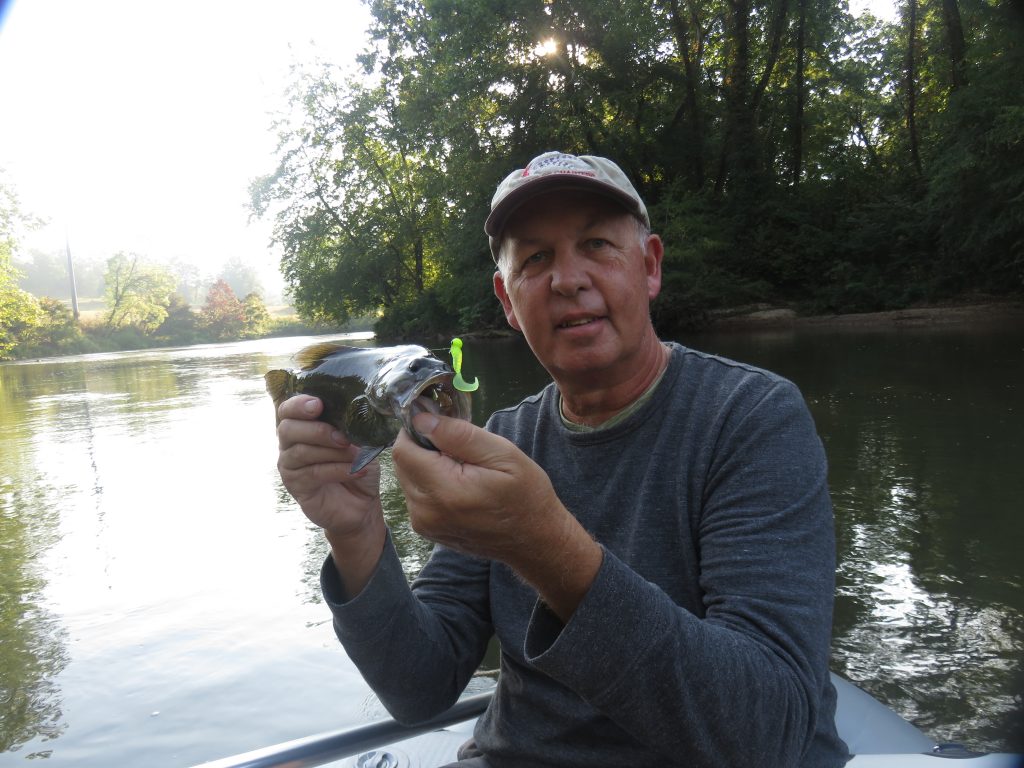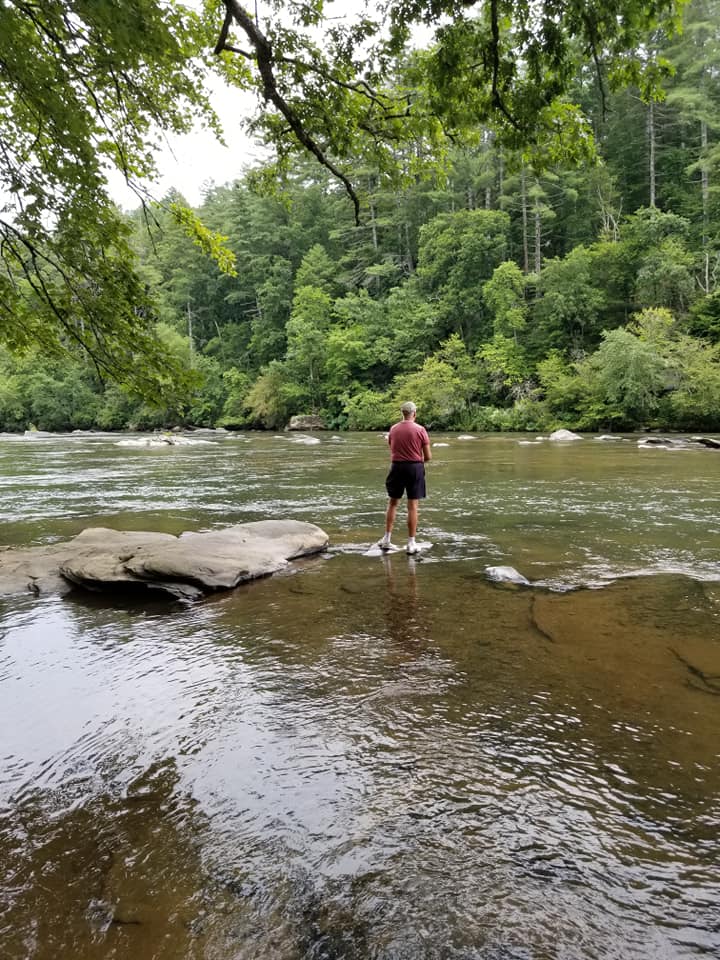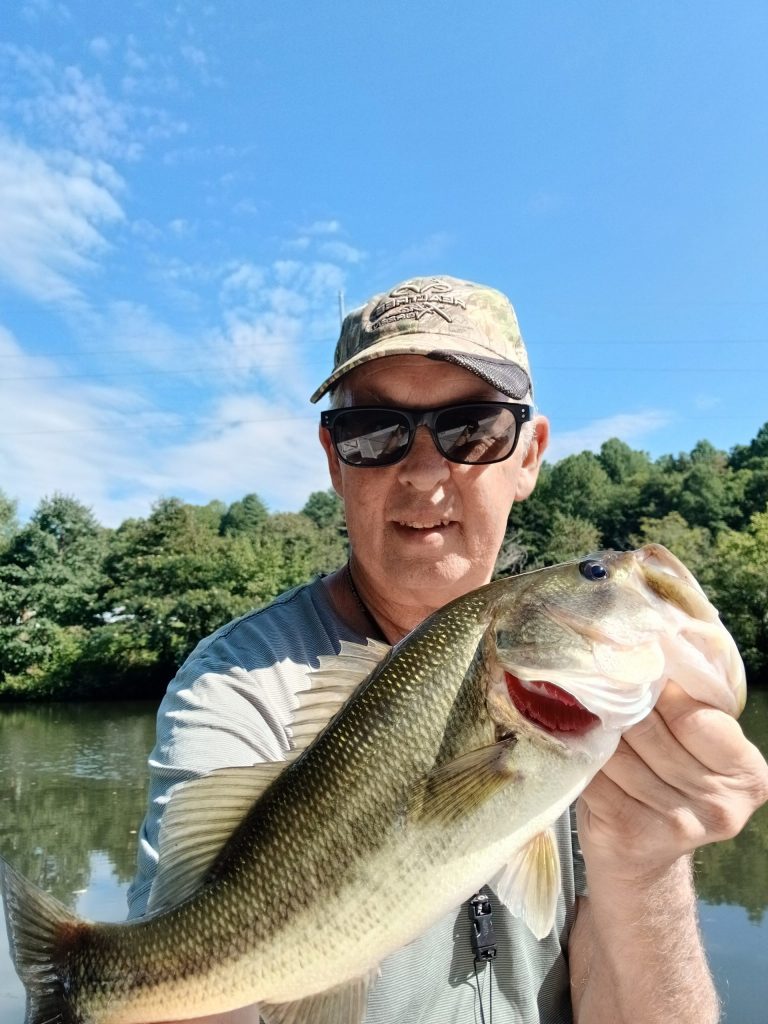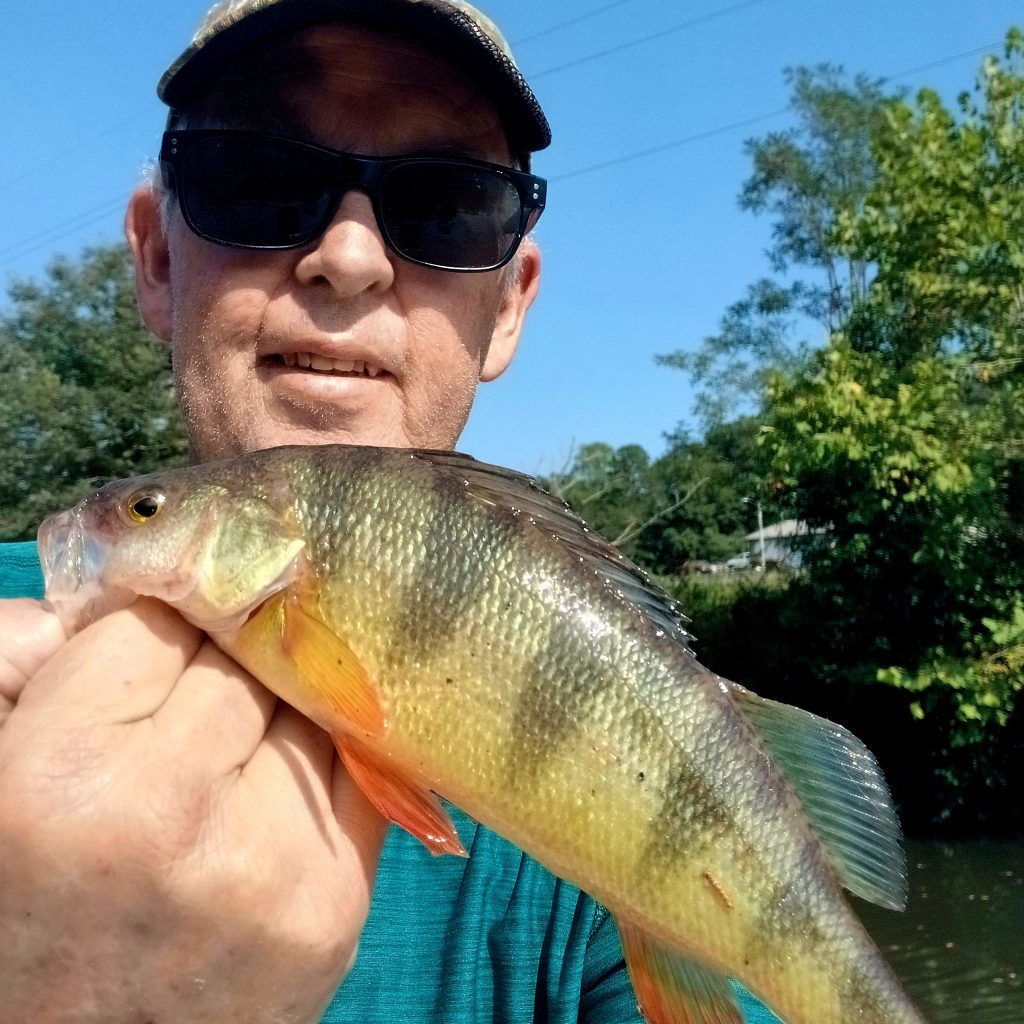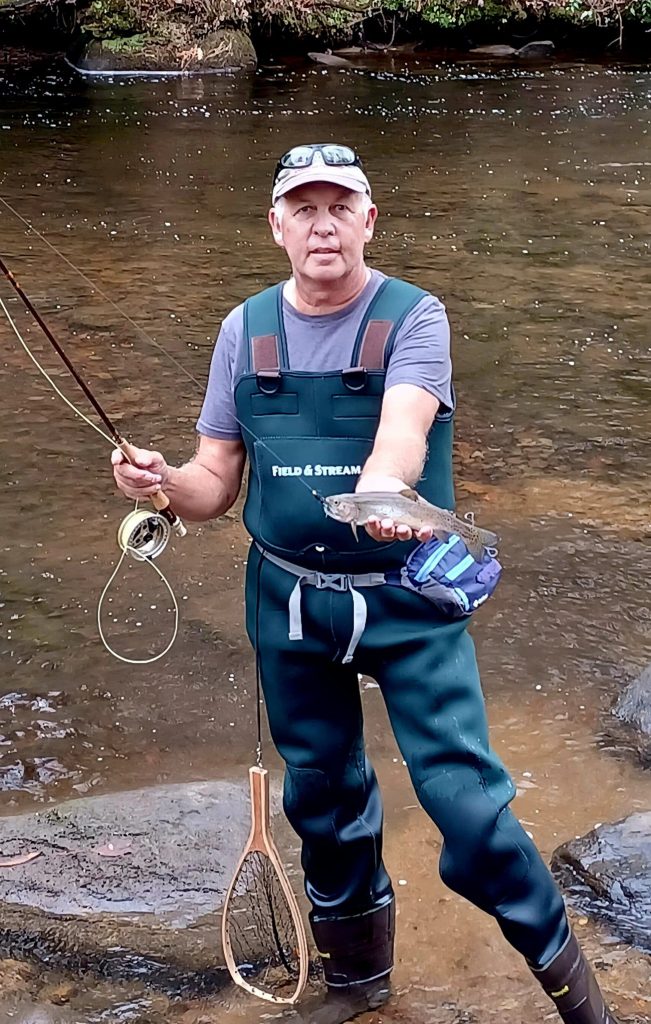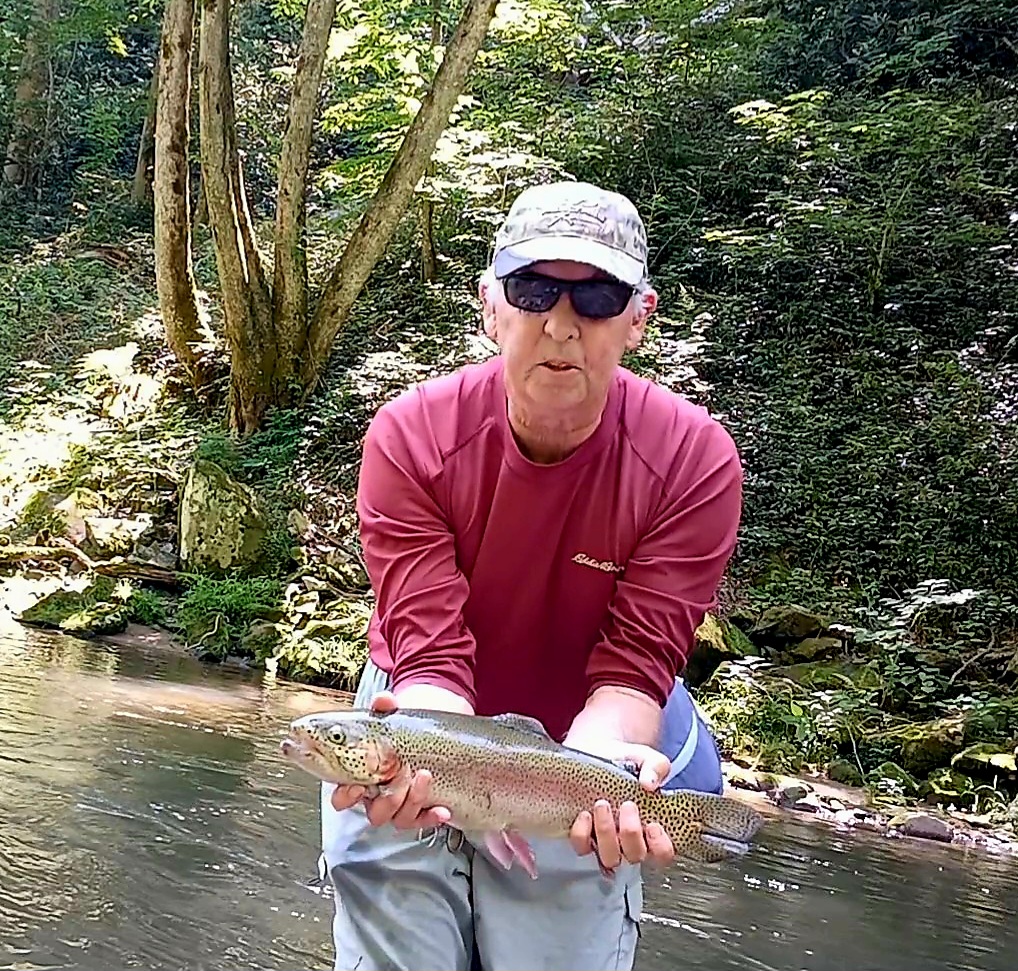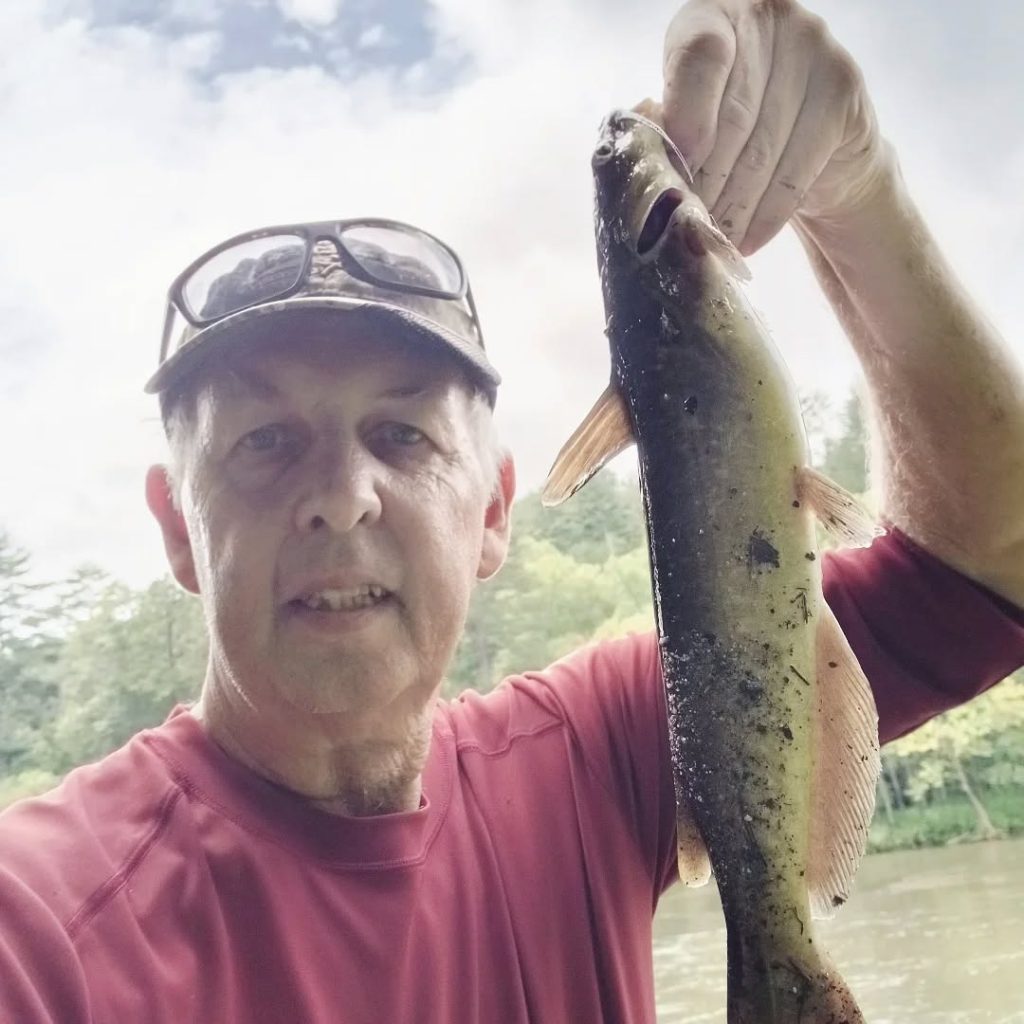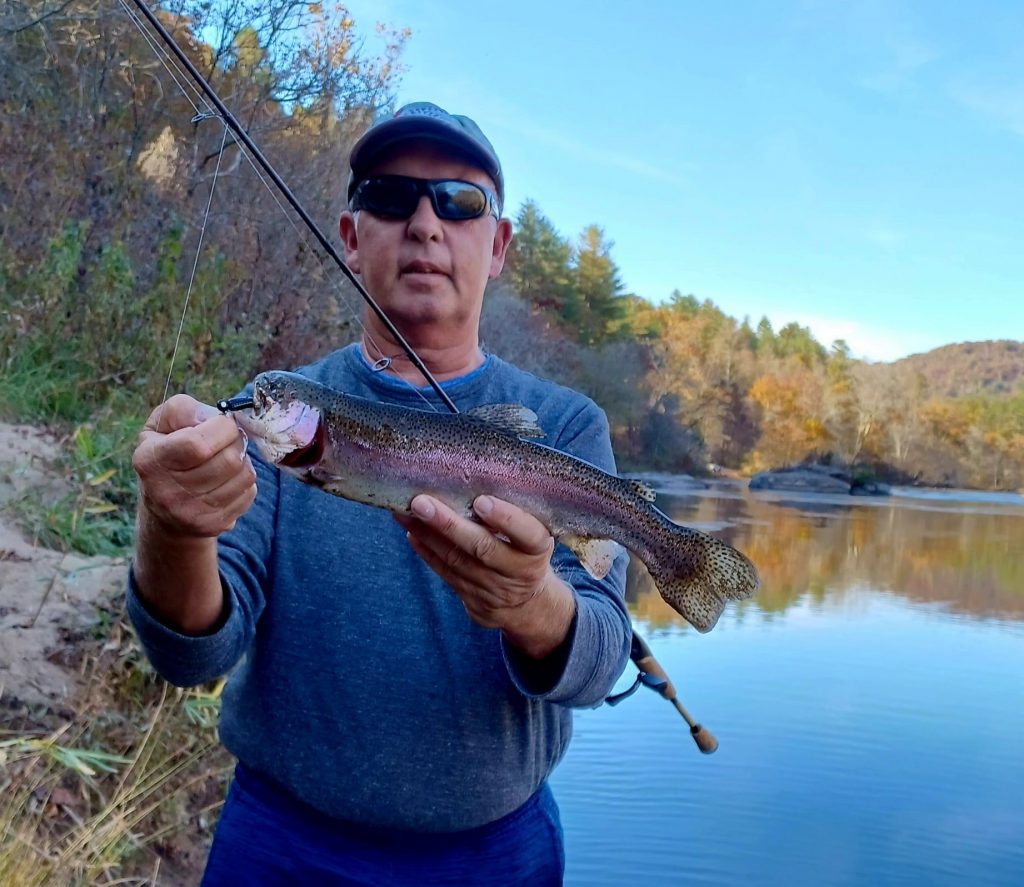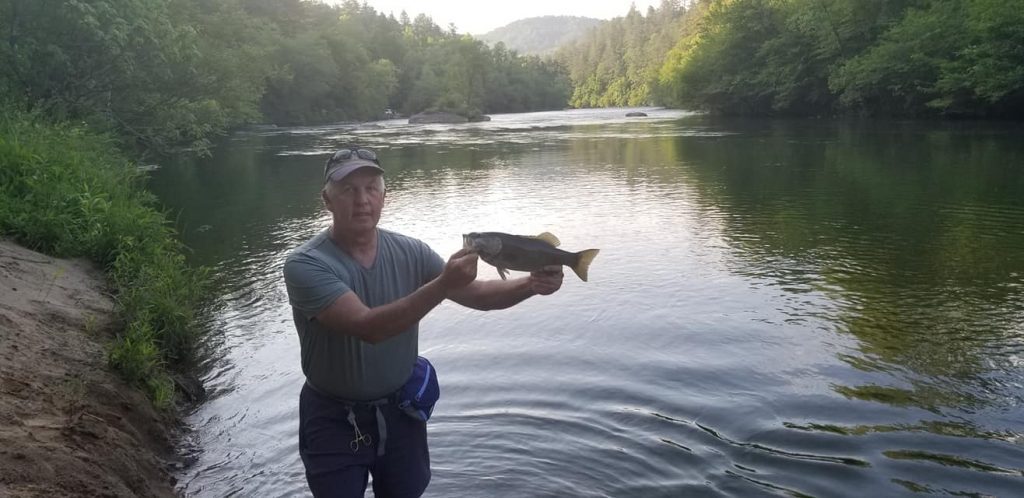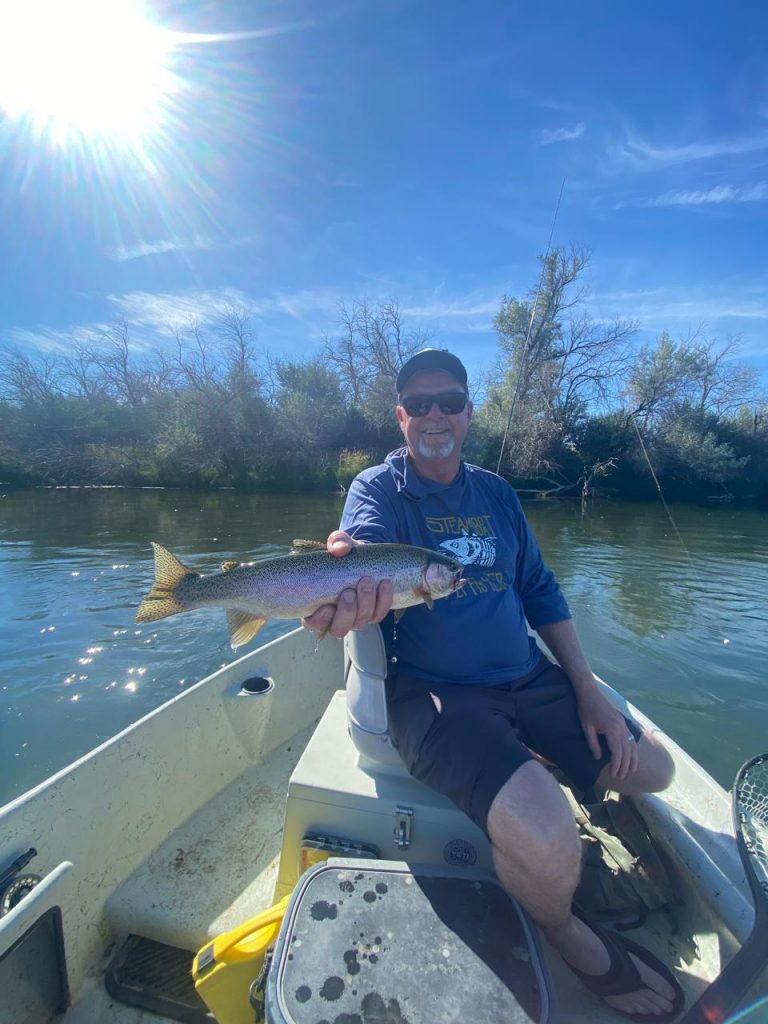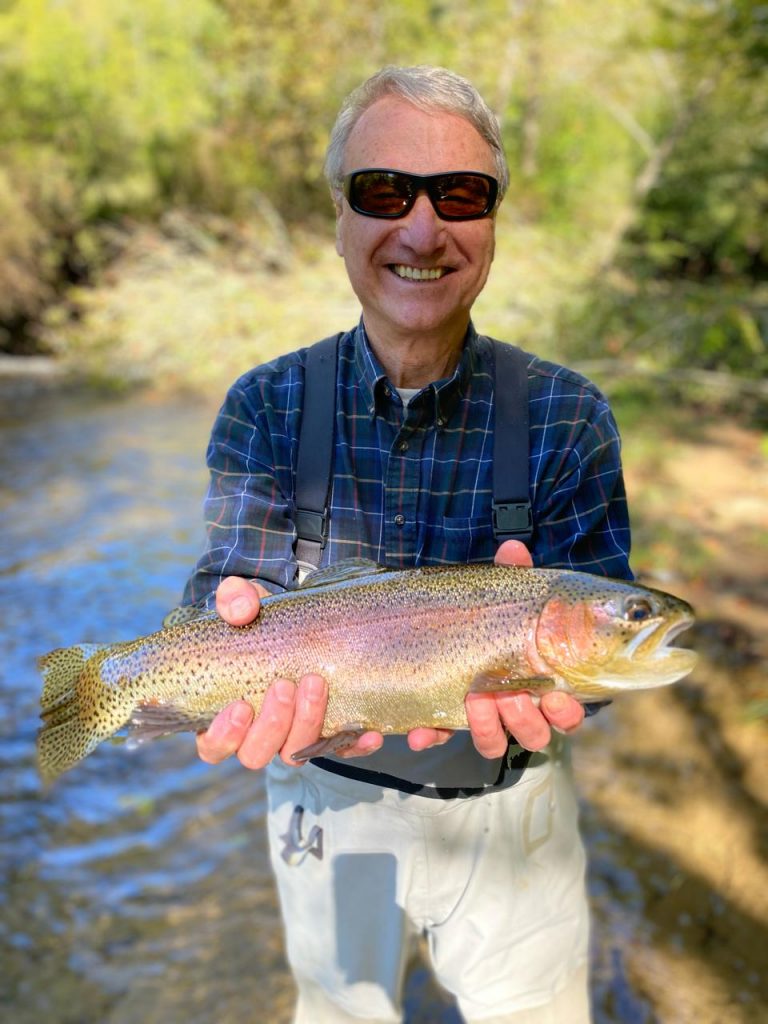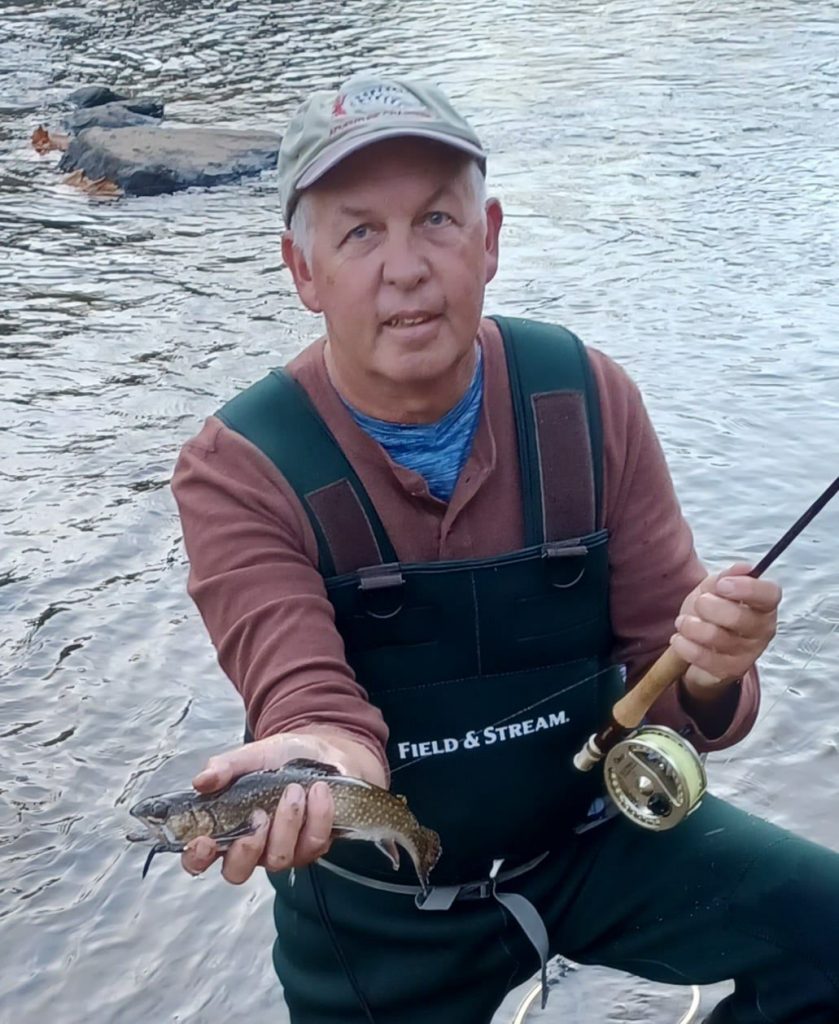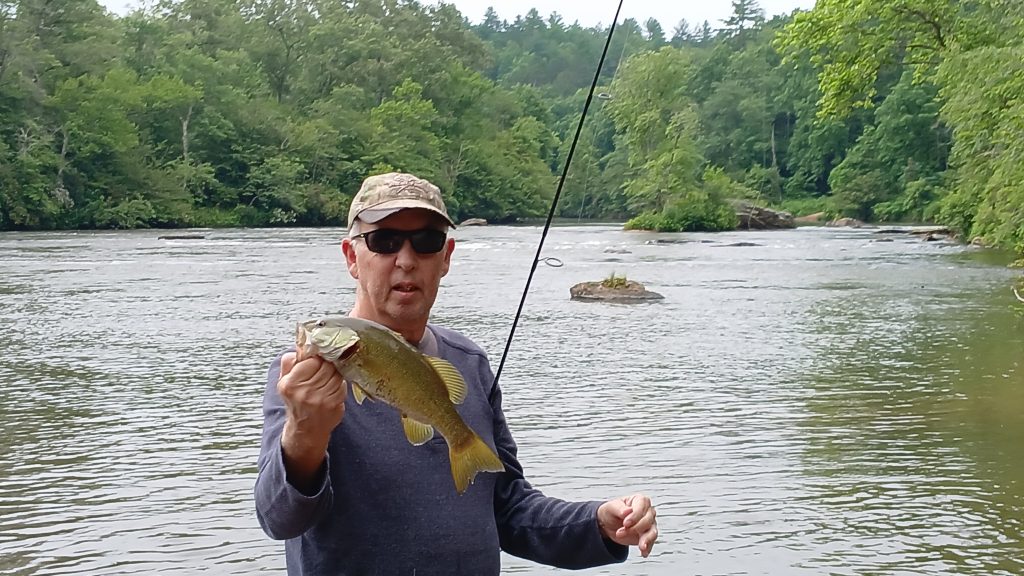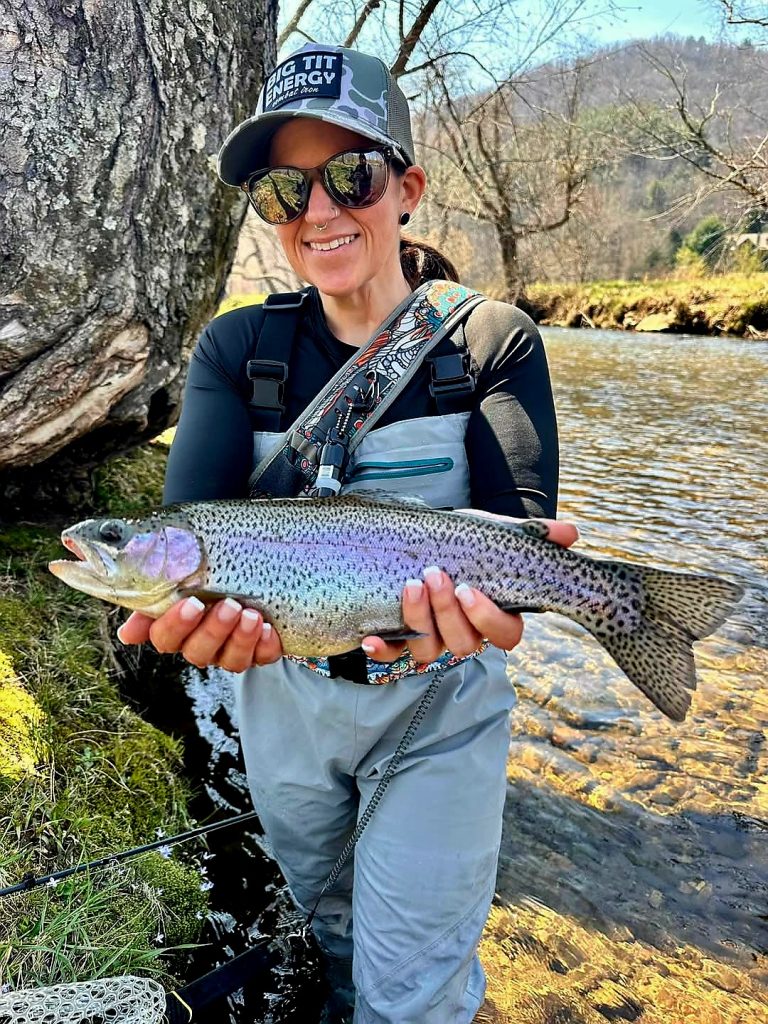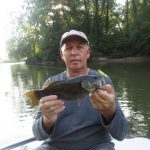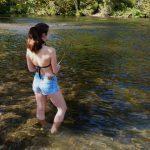Fishing in Franklin North Carolina
Anglers fishing Franklin North Carolina can experience some of the best trout and smallmouth bass action on the East Coast! The Little Tennessee River flows through the heart of Franklin, North Carolina. There is a dam on the Little Tennessee River that creates Lake Emory right in the center of Franklin. The river then flows north to eventually enter Lake Fontana. This stretch of the Little Tennessee River between Franklin and Lake Fontana offers anglers some fantastic smallmouth bass action! Trout, white bass, rock bass, catfish, panfish, walleye, and even musky are also available.
Franklin is a small town located in the mountains in the western part of North Carolina. It sits at an elevation of about 2000 feet above sea level. There are several rivers and lakes that are within an hours drive of Franklin. These bodies of water offer anglers a wide variety of fishing opportunities.
Read more about guided fishing in North Carolina
Lake Emory Is the portion of the river behind the dam. While termed a lake, it really looks and fishes much like a river. There is little structure in the middle, most of the cover is along the shoreline. This makes it an easy lake to fish. There is a nice ramp in town and several access points for canoes, kayaks, and smaller portable boats. In my opinion, this lake is overlooked given the convenience and comfort and is very lightly fished. It does get very muddy after a good rain.
Call Capt Jim at (941) 371-1390 or e-mail captjimklopfer@gmail.com
Lake Emory is full of panfish, perhaps too many. Several sunfish species, bluegill, crappie, and yellow perch are available. A lot of the fish are small, but provide fast action and persistent anglers can usually catch enough for a meal. Worms, small lures, and flies work well. I really like fly fishing with poppers. Largemouth, smallmouth, and spotted bass are in the lake as well. Standard lures work fine. Catfish and carp are caught by anglers bottom fishing. Trout will flush in from Cartoogechaye Creek and the Cullasaja River.
Fishing Franklin area rivers
Many anglers visiting the Franklin North Carolina area are targeting freshwater trout. There are several rivers which offer anglers outstanding opportunities to catch rainbow trout, brown trout, and brook trout. Perhaps the best well-known of these is the Tuckasegee River. It is only a 20 minute drive from Franklin. The Nantahala River is a world-class trout fishery as well and is located an hour west of Franklin, North Carolina.
The Cullasaja River flows from Highlands, North Carolina and eventually empties into the Little Tennessee River. This is a very picturesque stream, and fairly easy to fish. Although the stream is stocked, there are many wild fish in there as well. This is part of the attraction. The Cullasaja is in a bit of a ravine and anglers need to take care when climbing down and wading as water levels can rise rapidly. However, there are a lot of pull-offs and spots to access the river with an easy walk. Nearby Cliffside Lake is a great family option.
Fishing the Little Tennessee River
As mentioned earlier, the little Tennessee River flows right through the heart of Franklin, North Carolina. Anglers fishing the Little Tennessee River have multiple options. The river flowing from the south to Lake Emory is small and is best navigated with the canoe or kayak. It offers anglers the opportunity to catch smallmouth bass, panfish, and catfish. There is very limited access.
A dam in Franklin creates Lake Emory. This lake is a few miles long and not very wide. It has good shoreline cover with many downed trees and other fish holding structure. Bluegill, sunfish, and smallmouth and largemouth bass are the primary targets, though catfish, carp, rock bass, yellow perch, and even trout can also be taken there. A very nice boat ramp makes for easy access. There are also several spots to launch canoes and kayaks along the Greenway.
Most serious anglers target the section of the Little Tennessee River that flows north from Lake Emory to Lake Fontana. This is classic smallmouth bass water! There are many nice riffles and runs with slower, deep sections and pools in between. Anglers can access the river by wading as well as floating with canoes, kayaks, and rafts. The river is too shallow and rocky for any motorized vessel.
Fishing the little Tennessee River from Lake Emory to Tellico Road
The little Tennessee River can be broken into two sections as it flows out of Lake Emory. The first section, from the dam to Tellico Road, is best floated. There are several access points were anglers can put in and take out their crafts, making it easy to set up a nice float. This section is deeper, which makes it better for float fishing and not as good for wading.
Anglers can access the river at several locations. The first spot is right in the tail water of the dam itself. There is public parking and a path that goes down to the river. Several miles downriver is the route 28 bridge. There is a park at this bridge with a nice deep pool. There is another little park at Cowee Mounds, but it is a little steep.
The next public access is Rose Creek bridge. This is a bit of a ways from the route 28 bridge. The bank is a little steep as well with rocks. This stretch of the little Tennessee River has a lot of private land. The owner of great Smoky Mountain fish camp and safaris does own several pieces of property in this area. He can arrange for anglers to be picked up and shuttled back to their vehicles. This is very convenient!
Several miles downriver from the Rose Creek bridge is Queen Branch Preserve. This is a nice spot for anglers to put in and take out. It has plenty of parking. However, it is a short distance from parking to the river, so anglers will have to haul their gear. The path is fine in the grade is not steep.
Fishing the Tennessee River from Needmore Road to Lake Fontana
the little Tennessee River changes in character right around the Tellico Road bridge. It widens out and gets shallow. This makes for excellent wading but can be difficult for anglers to float, especially when water levels are low. Needmore Road and Upper Needmore Road parallel the little Tennessee River for several miles. There are numerous pullouts and access points for anglers to wade as well as put in small canoes and kayaks.
There are several parks developed by the government for accessing the river. These are Rattlesnake Creek, Brush Creek, Wiggins Creek, and Sawmill Creek. Here is a good map of the access points on the Little Tennessee River.
Eventually, the little Tennessee River empties into Lake Fontana. There are a couple boat ramps near this point were anglers can put in larger boats such as bass boats. They can then enter the mouth of the river and worked their way a few miles upstream before it gets too rocky. This can be an excellent place to find schooling white bass and other species, particularly in the fall.
Fishing the Tuckasegee River
The Tuckasegee River, or the “Tuck” as it is known locally, is one of the top trout streams on the entire East Coast. It is heavily stocked, with the delayed harvest section of the river from Webster to Silva having as many trout per mile as any River in the United States. Anglers flock to this stretch to experience some world-class trout fishing!
The Tuckasegee River begins its life in the North Carolina mountains. It is dammed a couple of times forming lakes Bear Creek, Cedar Cliff, and Wolf Creek Lakes. It then flows in a westerly direction, running through the towns of Tuckasegee, Webster, Silva, and Bryson city before emptying into Lake Fontana. The entire section is stocked with rainbow trout, brown trout, and brook trout. The lower section of the river from Bryson city to Lake Fontana offers anglers the chance to catch a trophy smallmouth bass as well.
There are excellent access points for anglers fishing the Tuckasegee River. Numerous parks were created with surfaced ramp’s, offering anglers with canoes, kayaks and drift boats access. Quite a few guides and outfitters use these access points and offered drift boat trips to anglers. This has a feel that is very similar to fishing the famous Western rivers in Montana and Idaho.
Anglers can certainly wade the Tuckasegee River as well. Route 107 parallels many miles of the river. From Cullowee to Silva, several roads run parallel to the river with countless pullouts offering wading anglers stream access. State Road 74 parallels the river to Bryson city where Route 19 takes over. All in all, access is fantastic! Be advised, the safer wading is before Dillsboro, it gets deeper from there.
The Delayed Harvest sections get the most attention. There is one from the 107 bridge outside of Webster to Sylva and another in Bryson City. These are HEAVILY stocked and single hook, no bait, catch and release only from October to June.
The Tuck can be a dangerous river to wade! Anglers need to take care and monitor the dam releases in stream conditions. Anglers wading the Tuck from Webster to Lake Fontana are advised to wear a life preserver.
Fishing the Nantahala River
The Nantahala River flows from south to north and lies an hour or so west of Franklin, North Carolina. It is a gorgeous stream that flows through a steep ravine. There are really three sections to this River. The southern section which flows into Lake Nantahala offers excellent trout fishing. However, most of this section of the river is private with very little access. Standing Indian Campground is the best spot.
The section of the river downstream from Lake Nantahala and flowing north into Lake Fontana is broken down into two sections. For the first 6 miles from the dam, the stream only receives water from a few tributaries. This area is well-stocked in the delayed harvest section. It offers anglers some outstanding fly fishing opportunities as well is for the angler spin fishing.
About 6 miles or so downstream from the dam, a pipe at the pumping station discharges water from Lake Nantahala into the river. This is what creates the very fast flowing section of the river. Tubers and white water canoeists and kayakers enjoy this section of the river. Anglers can experience some excellent fishing in the section of the river. It is highly recommended to go with a licensed outfitter and drift the river in a raft. Wading this section of the river when water is running can be very dangerous!
Access to the Nantahala below the dam is excellent. Several roads including Junaluska Road, old River Road, and Wayah Road parallel the river for many miles. There are countless pull offs and areas to park for anglers to access the river. Keep in mind that this river does get a lot of fishing pressure, particularly on the weekends. Though it is a remote setting, anglers will not have this river to themselves.
Fishing the Cullasaja River
The Cullasaja River is really more of a stream that a river. A dam in Highlands, North Carolina creates Lake Sequoyah. From there, the river flows through the ravines in the mountains, eventually emptying into the little Tennessee River. US Highway 64 parallels the river offering anglers good access. It is a beautiful stream offering anglers the chance to catch a native brook and rainbow trout. The Cullasaja is conveniently located to anglers staying in either Franklin or Highlands North Carolina.
The stretch of the Cullasaja River that is most productive for trout fishing is from Goldmine Road to Dry Falls. It is probably not the best choice for novice fly anglers. Some climbing is required in the rocks can be slippery, so anglers should take care. Also, flash flooding can occur in while the river is small it can gain in velocity and volume quickly so anglers should take care when wading.
Fishing Cherokee North Carolina
Cherokee North Carolina is another very popular trout fishing destination for anglers basing out of Franklin. This is all tribal water owned and operated by the Cherokee Indians. There are some 30 miles of streams and rivers that anglers can access. A $10 per day tribal fishing permit is required. A North Carolina state fishing license is not required. These waters are heavily stocked.
The Ocanaluftee River (known locally as “the Luftee”) and the Raven Fork run through these tribal waters. Several roads parallel these rivers and offer many pullouts and access for anglers. All fishing methods may be used including live bait in the catch and keep waters. Anglers may keep up to 10 fish per day.
There is a several mile section of trophy water. Anglers fishing the trophy section must fly fish with marvelous hooks and all fish must be immediately released. There are some true trophy fish in the stretch! Anglers cannot have any fish in their possession while fishing this portion of the river.
Cherokee is a bit “touristy” and some anglers will not enjoy the experience. It gets quite crowded, especially in late spring and again in the fall when the leaves change. Also, there is very much a “put and take” approach to these waters. However, the scenery is pretty and it is a good opportunity for the casual angler to spend the day out on the water.
Franklin area lakes
While the stream fishing for trout and smallmouth bass gets the majority of fishing attention, there are a half-dozen lakes within an hour of Franklin that offer anglers some excellent fishing as well. These include Glenville Lake, Cedar Cliff Lake, great Bear Lake, Lake Fontana, Lake Nantahala, and Lake Chatuge.
Most of these are your classic mountain lakes with steep shorelines in clear water. Smallmouth bass, spotted bass, largemouth bass, white bass, rainbow trout, brown trout, and walleye are the top species available. Lakes are listed by distance from Franklin
Glenville Lake
Glenville Lake is the closest Lake to Franklin. It is about a 40 minute drive to the east. This is a beautiful lake and is at the highest elevation of any Lake east of the Mississippi River. Surprisingly, Glenville Lake offers anglers a chance to catch decent size largemouth bass. This is a bit unusual for a mountain Lake. Smallmouth bass, walleye, and trout are also present in decent numbers.
Glenville like does get a lot of recreational traffic in the summer time. Anglers will do best fishing on weekdays and early and late in the day is best. Spring and fall are excellent times to fish as the water is cooler and the crowds are not present. There are several nice boat ramps offering good access to Lake Glenville.
Cedar Cliff Lake
Cedar Cliff Lakes is a smaller, lower lake that is formed by a dam on the east fork of the Tuckasegee River. It is 120 acres and 4 ½ miles long. It is not stocked but offers good fishing for largemouth bass, smallmouth bass, trout, and panfish.
Cedar Cliff Lake is a bit more remote and does not get the fishing pressure that Glenville does. There is an excellent surfaced ramp at 3072 state road 1132, Tuckasegge, NC
Bear Lake
Bear Creek Lake is a bit larger than Cedar Cliff lake at 475 acres and a little over 13 miles of shoreline. Smallmouth bass and trout are the primary attractions for anglers. However, largemouth bass, crappie, and panfish are also available. It is stocked by the state.
The water does not drop off as steeply in Bear Creek Lake as it does on some other mountain lakes. This results in a nice “zone” between 10 feet deep and 30 feet deep along the shore. Jerkbaits produce some nice smallmouth bass as well as largemouth. The boat ramp is at the end of state road 1137 off of 281.
Fontana Lake
Fontana Lake is huge! Fontana Lake is the 4th deepest lake in the US, and the deepest lake east of the Rocky Mountains. Fontana Lake is 31 miles long. It has 210 miles of shoreline and the average depth of the lake is over 100 feet deep. It is an easy 45 minute drive from Franklin on good, two lane highways.
The fishing on Fontana Lake can be very good. The list of available species is long and includes largemouth Bass, smallmouth bass, walleye, muskie, spotted Bass, rainbow and brown trout, catfish, and panfish. Fallen trees and sloping rocky points are great fish-holding structure.
Spring rains cause water level in the lake to rise. This triggers a spawning run up into the tributary rivers. Steelhead move upstream in April through May and offer some great afternoon into late evening fly fishing on the mouths of the Tuckasegee and Little Tennessee Rivers.
Summer will find bass on the main lake points and channels. Early and late in the day is best. Anglers will find schooling fish on the surface at times. This is especially true in late summer and early fall as water levels drop. Fish will move from the rivers into the main lake.
There are several public boat ramps on Fontana Lake. Most anglers leaving Frankin use the Lemmons Branch boat ramp.
Lake Nantahala
Lake Nantahala is a deep, clear mountain lake. The scenery is spectacular! This 1600 acre lake is about an hour west of Franklin. It is off of Wayah Road, which is truly a mountain road! The lake supports a variety of game fish, with trout and smallmouth bass being the most popular species.
Lake Nantahala used to support a landlocked kokanee salmon population. However, that fishery seems to have collapsed the last few years. The shoreline drops off sharply into deep water. Anglers work rocky points and shoreline cover. This is not an easy lake to fish, but the scenery and solitude alone make it worth the trip.
There are two public boat ramps on Lake Nantahala. Most anglers basing out of Franklin use the Rocky Bran
Lake Chatuge
Lake Chatuge is 45 minutes southwest of Franklin on a nice two lane highway. It straddles the North Carolina Georgia border. It is a large lake and has a “southern” feel. Lake Chatuge is around 7,000 acres with 130 miles of shoreline.
While Lake Chatuge is home to over thirty species of fish, bass are the main quarry of anglers. Largemouth, smallmouth, spotted, striped, and hybrid bass are available to anglers. The water is fairly deep without a ton of structure. Boat docks are prime spots, as are underwater points and channel edges. The most convenient boat ramp is at Ledford Chapel Road. Turn south on Ledford Chapel Road from 64, it is a mile or so to the ramp.
fishing for trout and smallmouth bass in Franklin
Smallmouth bass and trout are without a doubt the most popular fish species for anglers fishing Franklin North Carolina. Both trout and smallmouth bass flourish best in cold, clear water. The lakes, rivers, and streams of Western North Carolina provide this habitat perfectly.
Rainbow trout, brown trout, and brook trout are stocked heavily in Franklin area lakes, rivers, and streams. Often times, trout and smallmouth bass can be found in the same waters. However, there are some differences in habits, seasons, and angling tactics. Therefore, smallmouth bass and trout will be covered separately.
trout fishing
There can be no doubt that trout is king in Western North Carolina! Anglers flocked to the area from large southern cities such as Charlotte and Atlanta. In fact, anglers from the entire East Coast come to the famed Tuckasegee and Nantahala Rivers to try to catch trout on a fly. Both of these rivers are heavily stocked and offer anglers a Western-style trout fishing experience.
There are several designations of trout waters in this area. These are hatchery supported waters, delayed harvest waters, and wild trout waters. It can be a bit confusing as all three have different rules and regulations. However, most trout rivers and streams are well marked making it easy for anglers to comply with local laws.
hatchery supported trout waters
This is the simplest and easiest of the designations. Anglers can keep seven trout of any size for the entire year with the exception of March. Anglers may use live bait, artificial lures with treble hooks, and of course flies. These fish are for the most part put in these waters to be taken by anglers.
Hatchery supported waters are designated by signs along the stream bank. It is important for anglers to understand that if they keep fish and these hatchery supported waters, they can’t then fish closed waters while having fish in their possession. There is no way for law enforcement to know where those fish were actually caught.
Delayed harvest waters
Delayed harvest waters are exactly as the name implies; fish are stocked but anglers are not allowed to harvest the fish right away. This results in some fantastic catch and release angling in the stretches of river. The season opens on the first Saturday in June. At this point, fish are allowed to be kept.
The best actual fishing is in these delayed harvest trout waters. There is a famous stretch on the Tuckasegee River from Cullawee to Silva. This 7 mile stretch is heavily stocked with fish of all sizes, including some large ones. Most of the fish are rainbow trout. However, brown trout and brook trout can be caught as well. The number of fish per mile and this stretch of river is as high as anywhere in the United States.
Anglers fishing the delayed harvest sections of Franklin area rivers and streams must use flies or single hook artificial lures. Spinners, spoons, and plugs must have a single hook; no treble hooks are allowed. Live bait and prepared bait is prohibited.
There is another delayed harvest stretch of water right inside downtown Bryson city. The fishing can be terrific here as once again the fish density is very high. The river is also very accessible as it flows right through the city. Both of these stretches of delayed harvest water on the Tuckasegee get a lot of fishing pressure, particularly in the spring before the season opens up.
The Nantahala River has a delayed harvest stretch as well. The river is well marked with signs so anglers can differentiate the delayed harvest waters from the hatchery supported waters.
wild trout waters
Wild trout waters are once again pretty self-explanatory. These are streams where wild trout breed on their own. These waters are not stocked. Because of this, these waters are heavily regulated. For the most part, this designation is given to small mountain streams with populations of wild brook trout. This is especially true in the Smoky Mountains national Park.
trout fishing techniques in Franklin
Anglers spin fishing for trout and Franklin use several different techniques. Live baits work well, with worms and nightcrawlers being the top choice. There are many prepare baits which work well for trout and are very convenient. Anglers casting artificial lures do very well with small spinners, spoons, and plugs. Again, anglers need to be mindful of current regulations.
Light spinning tackle is the best option when trout fishing in Franklin area rivers, creeks, and lakes. A six-foot ultralight spinning rod with matching real and 4 pound monofilament line is a good all-around combo. Serious trout anglers will drop the line down to to pound test, especially when the water is clear. A very light rod and soft touch are needed to land a nice fish with this tackle.
Anglers using live and natural bait do well with worms, nightcrawlers, and commercially prepared baits. These commercially prepared baits can be eggs as well as dough or putty type baits. These come in a myriad of colors and scents. Anglers will do best to experiment with different baits until they find one that is productive on that outing.
Most anglers fish both live and prepared baits using a small hook under a float. A #8 hook is a good all-around size. A small split shot can be used a foot or so above the hook if current is present. Anglers should use the smallest float possible.
The top artificial lure for anglers trout fishing is the small in-line spinner. Every angler has his or her favorite, with rooster tails, maps, and Fox spinners being the most popular. These spinners come in a variety of sizes and colors. Anglers should experiment with blade and body colors until a productive pattern emerges. 1/16 ounce spinners are a good all-around size.
Spinners are excellent lures to use for trout fishing for several reasons. They catch fish of all sizes, both small fish and large. Spinners are very easy to use is angler simply cast them out, allow them to sink for a moment, then reel them in using a slow, steady retrieve. Finally, spinners allow anglers to cover a lot of water in search of fish.
Other productive artificial lures include small spoons and plugs. Spoons are a good choice in open water and lakes. They cast a long way and anglers can cover a lot of water in a short amount of time. Plugs are a very effective artificial lure for catching trout, especially larger specimens. Anglers trout fishing with plugs usually will catch as many fish, but they are generally larger.
river and stream fishing
Anglers spin fishing for trout will do well working the riffles at the heads and tails of polls. Deeper seams in the rapids are good places to drift a bait or lure. In the warmer months, trout will often seek the deeper water in the pools themselves. Reading trout water in understanding where fish hold depending on current conditions is a skill that can only come with experience.
Each of the Franklin area trout rivers and streams has a personality of its own. The Tuckasegee is a large river and fishes more like a Western trout stream. In most cases, the best approach is to float it. The Nantahala River is a very good choice for novice anglers as it is easily waded and fished in the non-tail water section of the river. The Cullasaja River is very pretty, well stocked, accessible, has wild fish, and the scenery is terrific!
Many books have been written on the subject of fly fishing for trout. We are not going to try to cover that here. What we will do is supply some excellent links to fishing reports, fly selection, and other good resources. Local fly shops are the best places to go for current information on fly hatches and river conditions.
Smallmouth bass fishing in Franklin
Smallmouth bass rank only behind the beloved trout for anglers fishing and Franklin. The little Tennessee River is renowned as one of the best smallmouth bass streams in the eastern United States. It is best known for having good numbers of fish, though there are certainly quality fish mixed in as well. The Tuckasegee River from Bryson city to Fontana Lake has a less fish in terms of numbers, but the average size will be larger. All of the area lakes have populations of smallmouth bass as well.
Smallmouth bass are much less fussy than are trout, and this is a good thing! Fishing for smallmouth bass is also an excellent option in the heat of summer when trout fishing really slows. Anglers can wait or float the little Tennessee or Tuckasegee River or fish one of the several area lakes that hold smallmouth bass.
Smallmouth bass tackle is pretty basic. Anglers will do well with a 6 foot to 6 1/2 foot light spinning rod and matching real spooled up with 6 pound or 4 pound monofilament line. In the spring time when the river levels are up, anglers can get away with a bit heavier tackle. However, by late summer the water is low in clear and light tackle works best. Fly anglers will do well with a 5wt or 6wt with an intermediate sink tip line.
While live bait certainly catches smallmouth bass, most anglers opt for using artificial lures when targeting these fish. Lures allow anglers to cover a lot of water fairly quickly. Also, smallmouth bass tend to be aggressive in nature and artificial lures will often times draw a strike. Finally, lures are just a lot of fun to fish!
The top artificial lures used when fishing for smallmouth bass are soft plastic baits, spinners and spinner baits, and hard bodied plugs. Each has their advantages and disadvantages but all of them catch fish.
Soft plastic baits are very effective for just about every fish that swims and smallmouth bass are no exception. A 4 inch watermelon Senko worms is deadly on smallmouth bass in both rivers and lakes. A 2 inch tube or grub body in a crawfish color fished on a 1/8 ounce or 1/16 ounce jig head is very productive as well. The one downside to fishing jigs in the rivers is that anglers will experience a fair amount of snags on the rocky bottom.
Plugs are an extremely effective smallmouth bass lure. The # 8 Rapala X-Rap in white or olive is a great all round bait. Anglers seeking larger fish and lakes can bump up the size to a #10. The lure is cast out and retrieved back using hard twitches with a pause in between. These plugs will generally dive a couple feet down which makes them a great choice in the deeper pools of rivers.
Many River smallmouth anglers swear by the rebel Wee Craw. This is a time proven smallmouth bass lure. It closely imitates a crayfish which is one of the smallmouth bass’s favorite meals. It also tends to bounce off rocks though anglers will occasionally hang up on the bottom.
Spinners and spinner baits are also very effective smallmouth bass lures. They are also quite easy to fish is angler simply cast them out and reel them back and steadily. Spinner baits in particular are fairly snag free. A 1/8 ounce spinner bait with a curly tail grub body and chartreuse, white, or root beer is a good choice. 1/8 ounce in-line spinners in a variety of color patterns will produce bass as well.
There are smaller streams which are either stocked or have decent populations of wild trout. These include Burningtown Creek, Cartoogechaye Creek, Chatooga River, Jarrett Creek, Kimsey Creek, Overflow Creek, Park Creek, Tellico Creek, and Turtle Pond Creek in Macon County. Jackson County strams include Flat Creek, Cullowhee Creek, Dark Ridge Creek, Greens Creek, Savannah Creek, Scott Creek, and Tanasee Creek.
Franklin area lakes
Many anglers visiting the Franklin North Carolina area are targeting freshwater trout. There are several rivers which offer anglers outstanding opportunities to catch rainbow trout, brown trout, and brook trout. Perhaps the best well-known of these is the Tuckasegee River. It is only a 20 minute drive from Franklin. The Nantahala River is a world-class trout fishery as well and is located an hour west of Franklin, North Carolina.
The Cullasaja River is a very technical trout stream that flows from Highlands, North Carolina and eventually empties into the Little Tennessee River. This is a very picturesque stream, though not easy to fish. Although the stream is stocked, there are many wild fish in there as well. This is part of the attraction. The Cullasaja is in a bit of a ravine and anglers need to take care when climbing down and waiting as water levels can rise rapidly.
Both the Little Tennessee River and Tuckasegee River offer anglers excellent smallmouth bass fishing. Both rivers empty into Fontana Lake. Anglers will find more variety in the areas where the rivers enter the lake. Spotted bass, white bass, walleye, catfish, panfish, and even musky are available.
